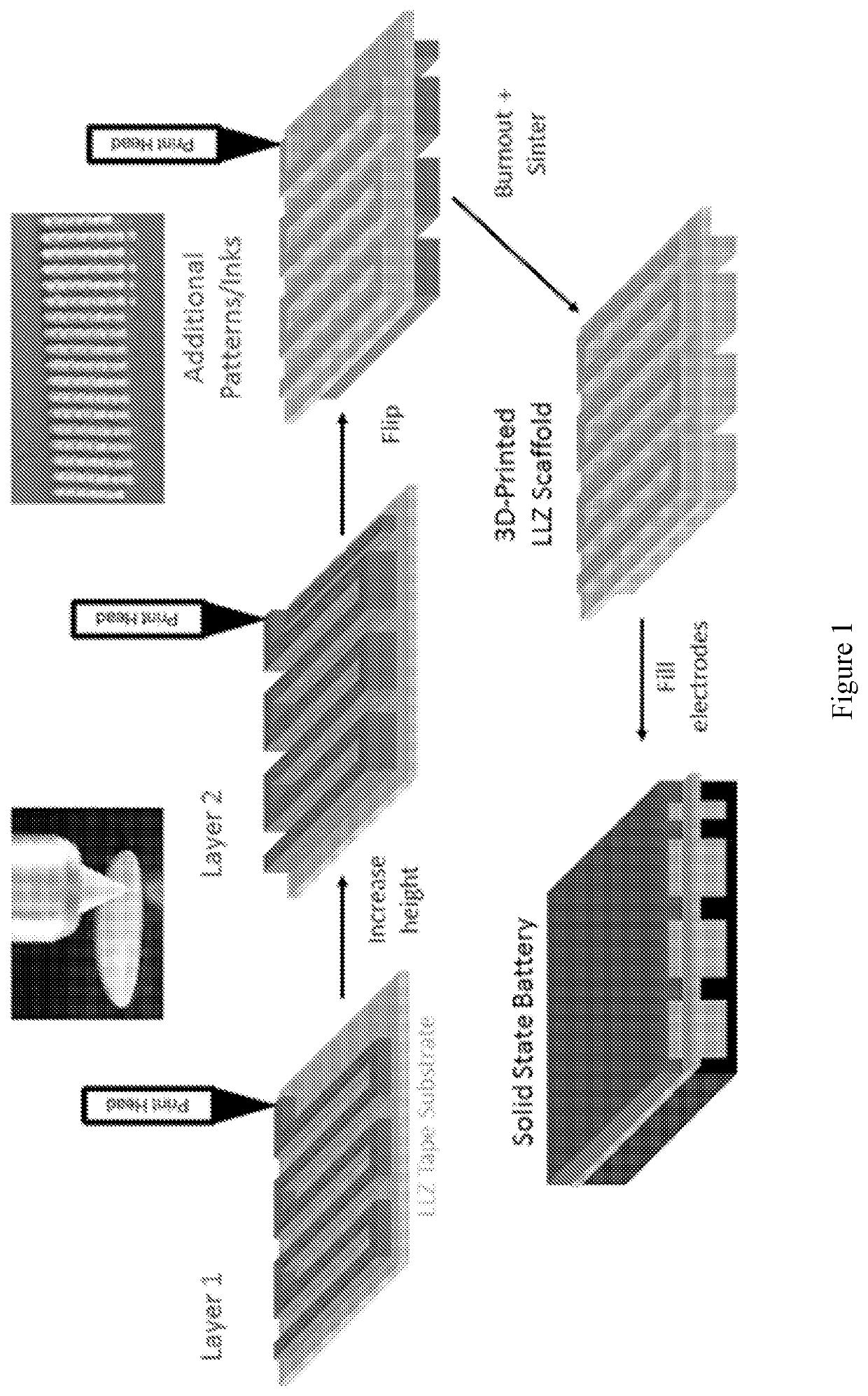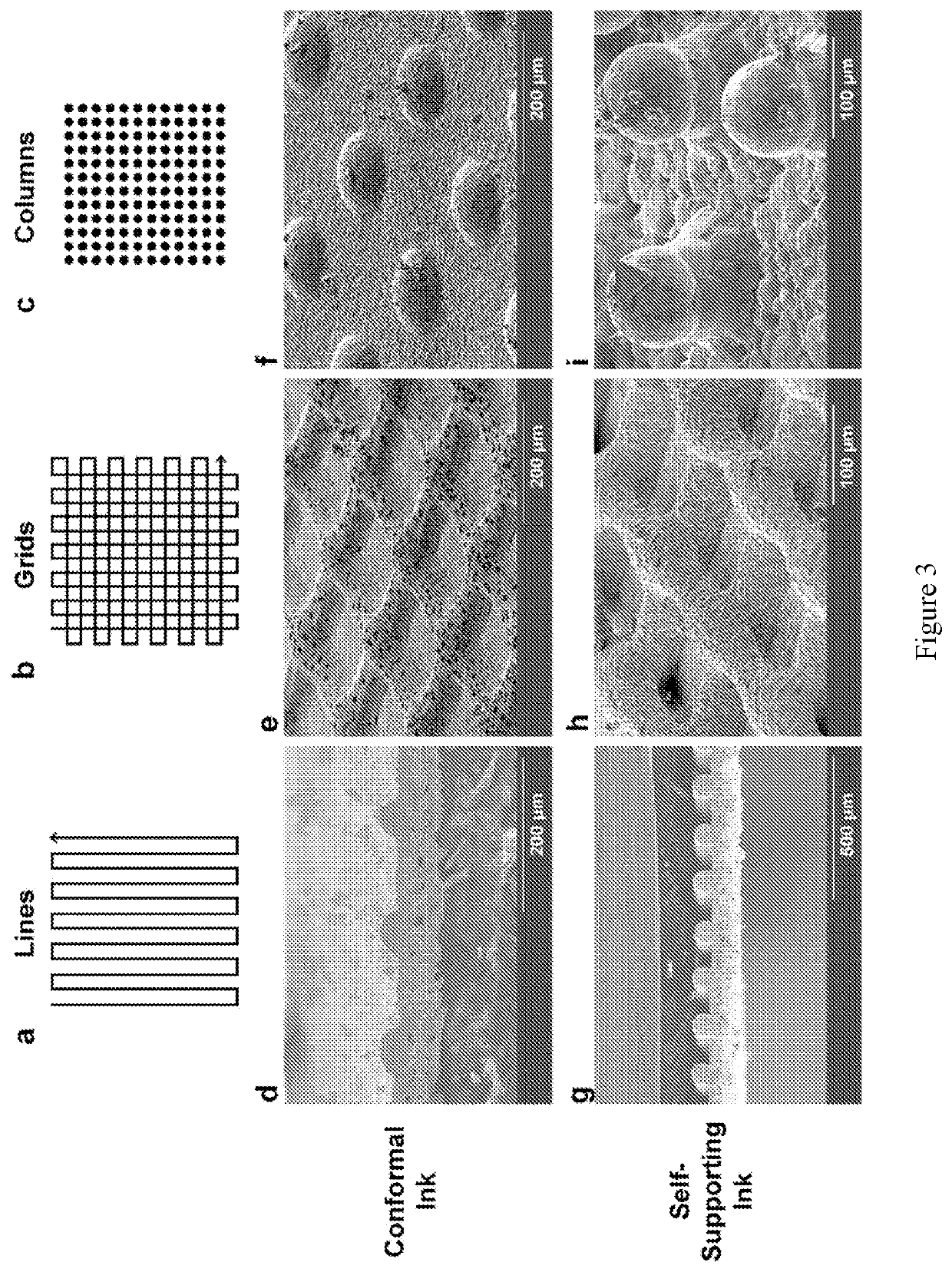Ordered porous solid electrolyte structures, electrochemical devices with same, methods of making same
a porous solid electrolyte and electrolyte technology, applied in the manufacture of final products, electrode manufacturing processes, silicates, etc., can solve the problems of catastrophic failure, battery energy density is limited, and lithium metal cannot be used in conventional li-ion batteries
- Summary
- Abstract
- Description
- Claims
- Application Information
AI Technical Summary
Benefits of technology
Problems solved by technology
Method used
Image
Examples
example 1
[0093]This example provides a description of solid-state electrolyte structures, devices comprising the solid-state electrolyte structures and characterization of same, methods of making solid-state electrolyte structures, and 3-D printable compositions.
[0094]This examples describes a sampling of structures printed and sintered revealing thin, and non-planar, intricate architectures comprised of LLZ solid electrolyte. To demonstrate the efficacy of the garnet inks, a symmetric Li|3-D printed LLZ|Li cell is cycled with low ASR. Other designs can also be obtained with the inks described in this disclosure. Using 3-D printing with the materials described herein can provide solid-state batteries with lower full cell ASR and higher energy and power density.
[0095]FIG. 1 shows an overview of cell fabrication using the 3-D printing process. This method is capable of printing a wide variety of ordered, high surface area LLZ structures which can be challenging to produce at the lab-scale with...
example 2
[0106]This example provides a description of solid-state electrolyte structures, devices comprising the solid-state electrolyte structures and characterization of same, methods of making solid-state electrolyte structures, and 3-D printable compositions.
[0107]This example describes 3-D printing of low tortuosity garnet frameworks. The 3D porous solid state electrolyte structures prepared by the present methods are ordered and can act as electrode supports, facilitating fast ion transport within the electrodes. This can enable higher battery C-rates and thicker electrodes for higher loading. The 3D structures can also increase the mechanical strength of the solid state battery.
[0108]Development of stable garnet ink with well dispersed garnet particles. Lithium garnet powder with the composition Li6.75La2.75Ca0.25Zr1.5Nb0.5012 (LLZ) was synthesized by solid state reaction. XRD results show pure cubic phase garnet in FIG. 8a. The powder was then ball-milled in multiples steps with decr...
example 3
[0113]This example provides a description of solid-state electrolyte structures, devices comprising the solid-state electrolyte structures and characterization of same.
[0114]A symmetric cell made using the 3-D printed stacked array LLZ and lithium electrodes was fabricated to validate the efficacy of the 3-D printed electrolytes (FIG. 11). The electrolytes were printed according Example 1. An ALD coating was applied to both sides of the LLZ to allow wetting of the lithium to the LLZ surface. FIG. 11a shows a diagram of the cell structure and FIG. 11b shows a closeup of the lithium metal filling the pores of the LLZ stacked array structure. Intimate contact between the lithium and LLZ and increased contact area provided by the 3-D printed LLZ pattern ensure low lithium metal|LLZ electrolyte interfacial impedance.
[0115]FIG. 11c shows the symmetric DC cycling of the cell. The current density was varied from 0.1 mA / cm2 to 0.33 mA / cm2 and back down to 0.1 mA / cm2. The average overpotentia...
PUM
| Property | Measurement | Unit |
|---|---|---|
| height | aaaaa | aaaaa |
| height | aaaaa | aaaaa |
| thickness | aaaaa | aaaaa |
Abstract
Description
Claims
Application Information
 Login to View More
Login to View More - R&D
- Intellectual Property
- Life Sciences
- Materials
- Tech Scout
- Unparalleled Data Quality
- Higher Quality Content
- 60% Fewer Hallucinations
Browse by: Latest US Patents, China's latest patents, Technical Efficacy Thesaurus, Application Domain, Technology Topic, Popular Technical Reports.
© 2025 PatSnap. All rights reserved.Legal|Privacy policy|Modern Slavery Act Transparency Statement|Sitemap|About US| Contact US: help@patsnap.com



